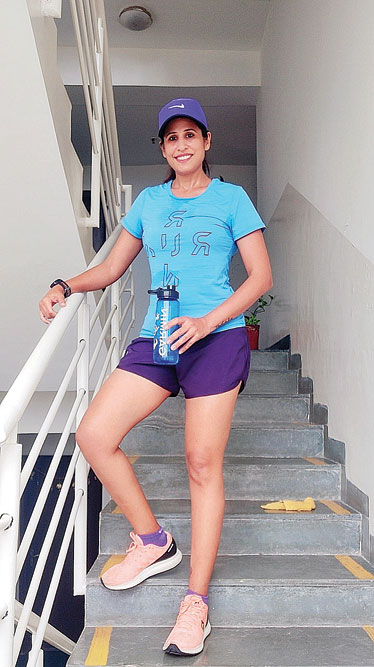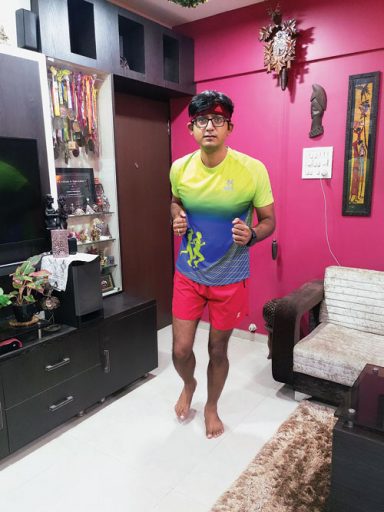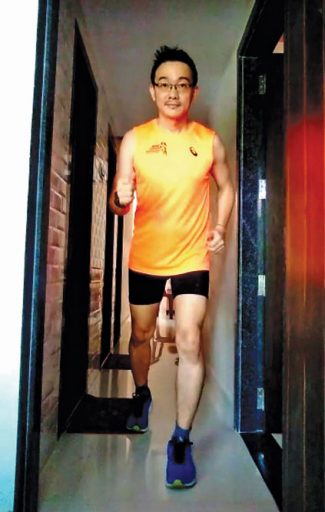Home Marathon
The reinvention of the long-distance runner
 Lhendup G Bhutia
Lhendup G Bhutia
 Lhendup G Bhutia
Lhendup G Bhutia
 |
15 May, 2020
|
15 May, 2020
/wp-content/uploads/2020/05/Homemarathon1.jpg)
(Illustration: Saurabh Singh)
I stand one morning, my back to the door of my house. Outside, the morning has erupted. Birds and butterflies flit to and fro. An unattended beehive grows heavy and noisy under a neighbouring flat. The sun is gentle; there is even a slight breeze. From a window I can see most trees are without leaf. But small flowers have fallen through the night. You cannot tell by looking at the housing society’s compound—it has been swept clean—but several lie forgotten on the roof of our cars.
It is a perfect day for a run.
I stretch myself and do a little warmup. I put on my earphones and push my mobile phone into my arm band. And as I take a sip from my water bottle, I consider the route before me. It begins where I stand, at the door; moves through a narrow corridor that connects to my hall-room; then, after a sharp right turn, a single loop around a dining table with its four undrawn chairs; followed by another right, this time into a room and, slightly tilting to the left, along a large unmade bed until I reach my balcony. At this point, I will retrace my steps, and do the same route over and over again.
Welcome to the strange new world of indoor long-distance running.
A little considered facet of the Covid-19 outbreak and the resulting lockdown has been its impact on running. Most fitness activities can get by. Yoga practitioners can roll out their mats and perform their asanas. Gym enthusiasts can lunge, squat and pick up weights.
But running doesn’t work like that. It is an entirely outdoor experience. Treadmills don’t count. To run is to be outside, to run from a spot to another. It is wonderful because while it is a fitness activity, it allows in this garb of physical wellbeing, I suspect, to also experience the world and yourself alone. Like a literary flâneur of the postmodern age, interested not just in the observation of the world but also himself, and, while at it, keeping fit.
But all runners have suddenly been told the world outside is dangerous. Even when the lockdown eases, running, it is believed, will be one of the things that will irrevocably change. Large crowded events such as marathons, which kickstarted this boom in running as a fitness activity, will not be permitted for fear of contagion. Even community running—where a group of few runners run together—will not be considered safe. According to one study—which hasn’t been peer reviewed yet—runners will also need to maintain more than the recommended six feet distance from one another. Measuring the increased airflow around runners, it has been suggested that a runner will have to maintain at least a 33 feet distance from an individual running (at a 14.4 km per hour pace) if they do not want to risk inhaling or having respiratory droplets land on their bodies.
A few long-distance runners in urban areas, it is said, are secretly venturing out before dawn. But the vast majority are locked in. Forbidden from stepping out and not particularly enthused by other forms of fitness activity, many long-distance runners are now turning to the limited space within the fore-walls of their homes. Many of these runs tend to be relatively short. But many are also doing half (21.1 kms), full (42 kms) and even ultra (50 kms) marathons. There are indoor running groups (operating through WhatsApp) and even indoor marathon events—complete with pet causes and dedications to Covid-19 frontline workers, or to mothers in the recently-held Mother’s Day—where e-certificates and virtual medals are distributed.

Mihika Wahi Gupta, a Gurugram-based long distance runner, says she started running inside her house on a lark. Gupta has been running full and ultra marathons for several years. Her longest run came a few years ago, when she ran in a group of 10 people from Gurugram to Jaipur, a distance of about 210 kms over three days (with a halt every night). A few days into the lockdown, she began to feel a strong restless desire for a run.
Mihika Wahi Gupta now runs two to three times inside her home every week. On other days, she runs on her building’s stairways. Her longest indoor run so far has been 50 km, which she completed in about six-and-a-half hours
“I had stopped running even before the lockdown because of fears over the coronavirus outbreak. So one day I thought, ‘Why don’t I do a small run of 5 kms in my house’,” she says. When she finished, she decided to go a little more, and after that a little more again. She eventually completed a distance of 21.1 kms.
“I really found it enjoyable. And getting from 5 kms to 10, to 15 and finally 21.1, I didn’t find it difficult at all,” she says.
Gupta now runs two to three times inside her home every week. On other days, she runs on her building’s stairways. Her longest indoor run so far has been 50 km, which she completed in about six-and-a-half hours. A few days ago, she claims to have completed the gruelling ‘4 x 4 x 48 challenge’ indoors, where an individual runs four miles (6.4 kms) every four hours for 48 hours. This run is supposed to be exceptionally gruelling because you are cumulatively running 48 miles (a little over 77 kms) with very little sleep and rest to recover in between. “It was crazy,” she says about her 4 x 4 x 48 challenge. “Because I would only sleep a little bit and then all the alarms would go off and I’d start running again.”
But running such long distances indoors comes with its own set of challenges. You can’t just prepare yourself, she says, you also need to prepare the house. So during these runs she gets her husband to cook and maintain the house, or sometimes—like during her 4 x 4 x 48 challenge—she prepared two day’s worth of meals for her husband and two sons in advance.
After she uploaded videos and photos of her indoor runs in her social media accounts and people began to show interest in the idea, Gupta organised an indoor running event last month. A second one is due later this week.

What helps Gupta is that she lives in a relatively large house. It measures about 2,400 square feet. Many others, especially those living in space-starved cities like Mumbai, have to do with much lesser.
Abhishek Bhattacharya, a media professional who lives in a 2 bedroom-hall-kitchen apartment in Navi Mumbai, has an incredibly short running track. Pushing furniture around, he gets a space of about 9 metres from the hall-room to a bedroom. He breaks the monotony by—mid-way through the run—changing the course of his run from the hall room and the kitchen, a distance of about 6 metres.
Abhishek Bhattacharya has a short running track. Pushing furniture around, he gets a space of about 9 metres from the hall-room to a bedroom
Bhattacharya admits that indoor running is incredibly boring. He has been doing them for the last two months—several times a week and completing a half-marathon twice—because he is afraid that if he goes on a break, he will stop running altogether. This had happened, when despite being a frequent marathon runner, he stopped altogether for a few years when he thought he was taking a brief break. When he returned to the activity last December after he had joined a committed group of runners (Furious Running Culture Foundation or FRCF), he was clear in his head, he says, that he would not allow himself to take such a break again.
When the lockdown was announced, Bhattacharya tried to work around the issue by using a resistance band he had recently purchased. Calling it a ‘rubber-band run’, where he would tie one end of the band on the grill of his balcony and the other end to himself, he would try to simulate long distance runs while the band kept him in one spot.
The group he belongs to, FRCF, has also taken up this form of running. After an event last month, another is due later this week. Milan Rai, the president of the group, an experienced full and ultra marathoner, plans to undertake a full marathon at this event. He suggests that people should jog rather than run inside their homes. “You should not be thinking about how quickly you are running. You anyway don’t get the space to build speed. And if you try to be faster, since you will be doing it on a cement floor, you will hurt your knees,” he says.
Bhattacharya does not wear shoes at these runs. He prefers to wear only socks. This makes less noise, he says, and gives more control. He also avoids taking turns to protect his ankle. Every time he is about to hit a wall, he slows down even further and instead of turning around, prefers to hop.
One of the biggest challenges to indoor running is measuring distances precisely. Since most mobile applications and fitness bands are built to measure outdoor runs, indoor runners complain that a majority of them do not log distances precisely. On a recent run, Bhattacharya tried to simulate an outdoor setting where his mobile phone would receive better network coverage, by opening all the windows and doors of his house. Even then, most apps failed to log precise details.

A more reliable way to gauge distances, these runners say, is by checking step counts. “On average, people with average strides take about 1,100 steps to complete 1 km [while running]. So you can roughly arrive at a distance estimate,” says Rai. This is, admittedly, however not a precise calculation. People can have longer and shorter strides, and indoors, people tend to jog more than run.
The biggest issue by far is that of boredom. In a long distance run usually, there is the company of others, and a constantly changing visual to keep you occupied. In an indoor run, you encounter the same flat unchanging scene. Some, like Bhattacharya, have got around this by distracting themselves by listening to audiobooks. Gupta blasts music from a speaker.
Milan Rai, the president of the Furious Running Culture Foundation, an experienced full and ultra marathoner, suggests that people should jog rather than run inside their homes
I usually go on long runs alone in a large stadium near my house. It is a beautiful place far away from the city. One half of the stadium is cloaked by trees. And on the other, several small hills rise. In clear nights, the ground is awash in a silver moonlight. During the days, there are all sorts of people, some playing, some chatting.
Once the lockdown was announced, I transferred my routine to my housing society’s large compound. But a week in—as has been the case with anyone who wields any amount of authority during this period—the housing society’s committee passed a rule forbidding anyone to run or walk in the compound. This, despite there being no Covid-19 cases anywhere near this neighbourhood.
And so now here I was at the start of my indoor run. I had pushed several pieces of furniture behind, but little edges still jutted out dangerously. There was the long shoe rack I had to be mindful of at the corridor, the edges from a dressing table and a chair, and the many colourful pieces of Lego blocks, train tracks and ambulances that the toddler in my house kept strewing about.
But by far the most demanding part was how tedious it all was. At the stadium, one- and-a-half lap gives me about 1 km. Here jogging from one end of the house to the other, I could cover about only 0.05 kilometre. I must have run at least 120 times to and fro. And how much ever I tried, whatever music or thrilling true crime podcast I listened to, the same flat unchanging scene imposed itself again and again.
When the lockdown was announced, it didn’t impact just runners. Walkers were also hit. My housing society’s edict applied to walkers too. I watched from the peephole of my house for the first month or so, my elderly neighbour who used to go for long walks twice a day, now often walking to and fro dizzyingly everyday through the short common corridor that connects his house to the others on the same floor.
In the last few weeks, this neighbour along with other walkers have managed to improvise by adding a large and prominent grocery bag to their attire. They now leave their homes with empty grocery bags, bravely take a round or two in the society compound, head outside the gates and return home an hour or two later with the bags still empty. So far they haven’t been challenged.
A runner with a grocery bag will, I suspect, not pass muster.

/wp-content/uploads/2025/07/Cover-Shubman-Gill-1.jpg)












More Columns
Shubhanshu Shukla Return Date Set For July 14 Open
Rhythm Streets Aditya Mani Jha
Mumbai’s Glazed Memories Shaikh Ayaz